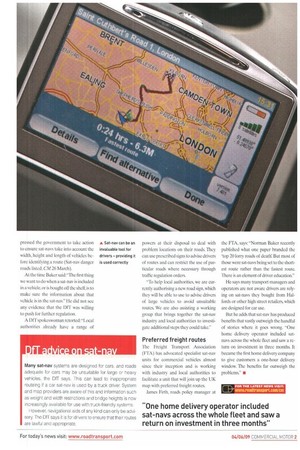Technology override
Page 20

Page 21

If you've noticed an error in this article please click here to report it so we can fix it.
Colerne in Wiltshire has reduced the number of truck drivers who blindly follow their sat-navs" directions through its narrow village streets. CM finds out how.
Words: Christopher VVattori SAT-NAV —JUST like the mobile phone and the interim we wonder how we ever lived without it. But its use in road transport has led to more than an occasional PR disaster when, for instance, lorries go trundling through idyllic English villages because the sat-nay tells them to.
In the Wiltshire village of Colemc, in the Box Valley between Bath and Chippenham repeated sat-nay mishaps, primarily by foreign drivers, led to villagers demanding a ban on HGVs using its narrow country roads.
Colerne parish councillor Phil Clamberlain tells CM the routeing of lorries through the village was down to the company that employed the drivers previously "not making any effort to put things right" and a lack of signs.
He adds: "Enough people pestered the leader of the county council that she took a personal interest in the issue. Suddenly we had meetings with the police, highways and the firm, whereas beforehand we weren't even getting our calls returned."
The company in question is CHEF, the multinational pallets specialist. In January, it issued a public notice to all the residents of the village offering its sincere apologies for the disruption or inconvenience it had caused.
It explained that Colerne airfield was being used for the seasonal overflow of storage of pallets from the south-west of the UK.The site is run by CHEF subcontractor Grupo Medrano UK and has capacity for 500,000 pallets, Consequently, between January and March last year, local haulage contractors made more journeys in the area and in October and December there were increased transport flows off-site to continental Europe by European haulage contractors MEP has had discussions with Wiltshire police and the Highways Agency as well as the district and parish councils to address the problem of HCiVs using inappropriate routes to and from the site. It agreed to tell contractors about appropriate routes and provide maps and instructions for sat-nay systems. It will also work with local police to issue financial penalties to haulage contractors that do not follow the correct routes
Noticeable improvement
CHEF has also agreed to work with the Highways Authority and local council to distribute and act on appropriate signs to direct HGVs and will participate in an ongoing review of the signs.
As a result of the protest Chamberlain says: "Now we have improved signage, maps are available from garages on the route to let lost drivers know the right way and CHEP says if we supply registration numbers then it won't pay any drivers who take the wrong roads.
"The situation has noticeably improved and although it took a little longer than necessary, in the end a co-ordinated effort by all involved has proved successful."
He adds: "The issue of the sat-nay remains, but that is something that affects many places and is difficult to resolve."
In March, Liberal Democrat shadow transport secretary Norman Baker
pressed the government to take action to ensure sat-nays take into account the width, height and length of vehicles before identifying a route (Sat-nay danger roads listed, CM 26 March).
At the time Baker said: "The first thing we want to do when a sat-nay is included in a vehicle, Otis bought off the shelf, is to make sure the information about that vehicle is in the sat-nay." He did not see any evidence that the DfT was willing to push for further regulation.
A Dfl' spokeswoman retorted: "Local authorities already have a range of powers at their disposal to deal with problem locations on their roads. They can use prescribed signs to advise drivers of routes and can restrict the use of particular roads where necessary through traffic regulation orders.
"To help local authorities, we are currently authorising a new road sign, which they will be able to use to advise drivers of large vehicles to avoid unsuitable routes. We are also assisting a working group that bring together the sat-nay industry and local authorities to investigate additional steps they could take."
Preferred freight routes
The Freight 'Itansport Association (FTA) has advocated specialist sat-nay units for commercial vehicles almost since their inception and is working with industry and local authorities to facilitate a unit that will join up the UK map with preferred freight routes.
James Firth, roads policy manager at the VIA, says: "Norman Baker recently published what one paper branded the 'top 20 lorry roads of death'. But most of those were sat-nays being set to the shortest route rather than the fastest route. There is an element of driver education."
He says many transport managers and operators are not aware drivers are relying on sat-nays they bought from Halfords or other high street retailers, which are designed for car use.
But he adds that sat-nay has produced benefits that vastly outweigh the handful of stories where it goes wrong. -One home delivery operator included satnays across the whole fleet and saw a return on investment in three months. It became the first home delivery company to give customers a one-hour delivery window. The benefits far outweigh the problems." • (-B... FOR THE LATEST HEWS VISIT' www.roadtransport.comicm
















































































































































